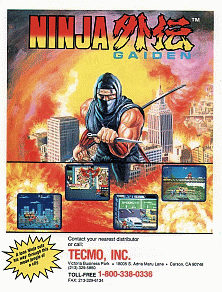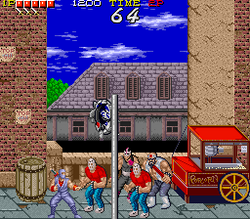Software:Ninja Gaiden (arcade game)
| Ninja Gaiden | |
|---|---|
 North American arcade flyer | |
| Developer(s) | Tecmo |
| Publisher(s) | Tecmo
|
| Director(s) | H. Iijima |
| Artist(s) | Shinobu Iwabayashi |
| Writer(s) | H. Iijima |
| Composer(s) | Mikio Saitou Ichiro Nakagawa Ryuichi Nitta Tamotsu Ebisawa |
| Series | Ninja Gaiden |
| Platform(s) | Arcade, Amiga, Amstrad CPC, Lynx, Atari ST, Commodore 64, MS-DOS, ZX Spectrum |
| Release | |
| Genre(s) | Beat 'em up |
| Mode(s) | Two-player, co-op |
Ninja Gaiden, released in Japan as Ninja Ryūkenden (忍者龍剣伝, lit. Ninja Dragon Sword Legend) and in Europe as Shadow Warriors, is a 1988 side-scrolling beat-'em-up game, originally released by Tecmo as a coin-operated arcade video game.[3] It was first released in North America and Europe in late 1988,[2][1] and then in Japan in February 1989.[2] It was the first game released in the Ninja Gaiden franchise. The arcade game was a major commercial success in North America, becoming the highest-grossing arcade conversion kit of 1989 in the United States.
Plot
Set in the retro-futuristic version on 1999, the player controls a ninja hired by the United States government[4] to defeat an evil cult led by Bladedamus, a descendant of Nostradamus who seeks to fulfill his end of the world prophecies. Flooding the streets of the United States with criminals released from Alcatraz, Bladedamus has kidnapped the President and acquired codes for launching the nation's ICBMs.[5][6]
Gameplay
The first player controls a ninja dressed in blue, while the second player controls one dressed in orange. Like most beat-'em-ups, players proceed through stages by defeating enemies scattered through each area.
The controls consist of an eight-way joystick with a button installed on top and two additional action buttons for attacking and jumping. The button on top of the joystick allows the player character to grab onto any overhead bar or tightrope and hang from there. There are five primary techniques performed by pressing the joystick and buttons individually or in combination with each other. These consists of the "Triple Blow Combination" (3段連続攻撃 Sandai Renzoku Kōgeki, a series of punches and kicks that serve as the player's standard attack), the "Flying Neck Throw" (首切り投げ Kubikiri Nage, performed by attacking the enemy while jumping), the "Hang Kick" (反動蹴り Handō Keri, performed by attacking the enemy while hanging from a bar), the "Tightrope Walk" (綱渡り術 Tsunawatari Jutsu, in which the player moves while hanging from or standing above a tightrope), and the "Phoenix Backflip" (飛鳥返し Hichō Gaeshi, a backflip performed after running into a wall), which becomes an attack if the player has a sword.
The player can destroy certain objects in the environment (such as telephone booths, signposts, dumpsters) by knocking or throwing enemies onto them. These will uncover hidden items that will award the player with bonus points, health recovery, time extensions and even an extra life. One particular item will temporarily arm the player with a sword that can be used up to ten times before reverting to his standard punches and kicks.
The first five stages are based on actual American cities and landmarks such as Los Angeles , New York City , Las Vegas, North Carolina, the Grand Canyon, and a transcontinental railroad. The sixth and final stage is set inside the enemy's hideout. The recurring bosses include a sumo wrestler, a pair of wrestlers resembling the tag team The Road Warriors known as the Daor Warriors (ドーロウォリアーズ), and a trio of claw-wielding masked acrobats known as the Men from Nanto (南斗の男たち Nanto no Otokotachi). The final boss, Bladedamus, wields two swords and has a fire breath attack.[7]
Ports
The Ninja Gaiden arcade game was produced and released almost simultaneously with its home console counterpart for the Nintendo Entertainment System, although they are different games with only a few similarities.[8] The designer of the arcade game is only credited as "Strong Shima", but Masato Kato, who worked on the NES version, identified him as one "Mr. Iijima".[9]
In Europe, home versions of Ninja Gaiden were released under the Shadow Warriors title in 1990 by Ocean Software for five different computer platforms (Amiga, Atari ST, Commodore 64, ZX Spectrum, and Amstrad CPC). In North America, it was published for the IBM PC by Hi-Tech Expressions, and as a single-player game for the Atari Lynx console by BlueSky Software. The arcade version of Ninja Gaiden is also included as a hidden bonus game in Ninja Gaiden Black for the Xbox in 2005.[10]
This game was ported to the Nintendo Wii as a downloadable Virtual Console Arcade game and released in Japan on July 28, 2009, in PAL regions on November 13, and in North America on December 21.[11] A Nintendo Switch port was released as part of the Arcade Archive series on May 9, 2019.[12]
Reception
| Reception | |||||||||||||||||||||||||||||||||||||||||||||||||||||||||||
|---|---|---|---|---|---|---|---|---|---|---|---|---|---|---|---|---|---|---|---|---|---|---|---|---|---|---|---|---|---|---|---|---|---|---|---|---|---|---|---|---|---|---|---|---|---|---|---|---|---|---|---|---|---|---|---|---|---|---|---|
| |||||||||||||||||||||||||||||||||||||||||||||||||||||||||||
The arcade game was a major commercial success in North America, becoming the highest-grossing arcade conversion kit of 1989 in the United States.[22] In Japan, Game Machine listed Ninja Gaiden on their March 15, 1989 issue as being the second most-successful table arcade unit of the month.[23]
The arcade game was well received by critics. Nick Kelly of Commodore User called it "the next generation for Double Dragon fans" with praise for the controls, background variety and two-player mode, but with some criticism towards the "slightly washed-out" graphics and "gory" continue screen.[1] Computer and Video Games called it a "slick beat 'em up" similar to Bad Dudes vs. Dragon Ninja (1988) with "smooth" graphics and "masses of action" that is "great fun" in two-player mode, despite the lack of originality.[14]
Reviewing the Atari Lynx version, Robert A. Jung with IGN said the story was irrelevant and the game was a scaled down version of the arcade original. He praised the graphics but in his final verdict he wrote that "Ninja Gaiden is not a bad game; it's just not a good game, either."[17] Rob Swan with Computer and Video Games said the game was exactly the same as the arcade coin-op and felt the game was a little short of superb but really addictive.[16] Les Ellis gave the game a positive review in Raze.[18]
Reviewing the ZX Spectrum version, Your Sinclair praised the colorful graphics and interactive backgrounds. Crash liked the animation, but had grown tired of the genre. Sinclair User summed it up with "there isn't really a speck of originality about Shadow Warriors. Nonetheless, it will be a stiff challenge." Reviewing the Amiga and Spectrum versions, C+VG highlighted the music and sound effects.
See also
- Rygar, another Tecmo game referenced in background graffiti
References
- ↑ 1.0 1.1 1.2 1.3 Kelly, Nick (19 December 1988). "Arcades: Shadow Warriors". Commodore User (United Kingdom: EMAP) (64 (January 1989)): 103. https://www.solvalou.com/arcade/reviews/275/306.
- ↑ 2.0 2.1 2.2 2.3 Akagi, Masumi (13 October 2006) (in ja). アーケードTVゲームリスト国内•海外編(1971-2005). Japan: Amusement News Agency. pp. 49, 138. ISBN 978-4990251215. https://archive.org/details/ArcadeGameList1971-2005/page/n50.
- ↑ "Ninja Gaiden". The International Arcade Museum. http://www.arcade-museum.com/game_detail.php?game_id=8881. Retrieved 6 October 2013.
- ↑ "Retro Game Museum". http://arcadefan.web.fc2.com/Ryukenden.html.
- ↑ Joe Yamada (February 1989). (in ja)Gamest 29: 103. http://www.geocities.jp/arcadon765/Ryukenden.html. Retrieved 2010-01-03.
- ↑ Satoshi Tajiri (1989-01-06). (in ja)Family Computer Magazine: 114–115. https://twitter.com/chou_nosuke/status/606052702246666241. Retrieved 2015-11-27.
- ↑ "ビデヲゲーム通信62" (in Japanese). ファミコン通信 (69 (1989, No.5)). March 3, 1989. https://archive.org/details/bi-weekly-famitsu-no.-69-march-3rd-1989/Bi-Weekly%20Famitsu%20-%20No.%2069%20March%203rd%2C%201989%20%28Compressed%29/page/n117/mode/2up.
- ↑ Hardcore Gaming 101 editorial staff. "Ninja Gaiden at Hardcore Gaming 101 - Interview with Masato "RUNMAL" Kato". http://www.hardcoregaming101.net/ninjagaiden/ninjagaiden12.htm. "Kato: Both (the arcade and NES versions of Ninja Gaiden) were developed side by side on the same floor, at the same time. However, we only shared the same title, while each team developed their game as they pleased."
- ↑ "Signature Series: Ninja Gaiden". Retro Gamer (Bournemouth: Imagine Publishing) (92): 78–81. July 2011. ISSN 1742-3155. OCLC 489477015.
- ↑ Brightman, James (February 10, 2004). "Ninja Gaiden Extras Confirmed...Again". GameDaily. http://xbox.gamedaily.com/game/news/?gameid=531&id=5418. Retrieved 2006-08-23.[|permanent dead link|dead link}}]
- ↑ "500th Downloadable Wii Game Makes for a Smashing Holiday Season". Nintendo of America. 21 December 2009. https://www.nintendo.com/whatsnew/detail/rpQF_Q37xeLw8On2hEAtGy8gmJwnNYqd. Retrieved 22 December 2009.
- ↑ "Arcade Archives | HAMSTER Corporation". http://www.hamster.co.jp/american_hamster/arcadearchives/switch/ninja_gaiden.htm.
- ↑ "Photographic image of game review" (JPG). https://wos.meulie.net/pub/sinclair/magazines/Crash/Issue80/Pages/Crash8000048.jpg. Retrieved 2016-10-19.
- ↑ 14.0 14.1 "Arcade Action: Shadow Warrior". Computer and Video Games (88 (February 1989)): 102–3. January 1989. https://www.solvalou.com/arcade/reviews/196/306.
- ↑ 15.0 15.1 "Photographic image of game review" (JPG). https://wos.meulie.net/pub/sinclair/magazines/Computer-and-Video-Games/Issue103/Pages/CVG10300017.jpg. Retrieved 2016-10-19.
- ↑ 16.0 16.1 Rob Swan (August 1991). "Lynx Lowdown". Computer Videogame Magazine (117): 37.
- ↑ 17.0 17.1 Robert A. Jung (6 July 1999). "The second Tecmo arcade conversion for the Atari Lynx is somewhat disappointing.". IGN. http://www.ign.com/articles/1999/07/07/ninja-gaiden.
- ↑ 18.0 18.1 Les Ellis (August 1991). "Ninja Gaiden". p. 54. https://archive.org/stream/RAZE_Issue_10_1991-08_Newsfield_Publishing_GB#page/n53.
- ↑ "Photographic image of game review" (JPG). https://wos.meulie.net/pub/sinclair/magazines/SinclairUser/Issue103/Pages/SinclairUser10300023.jpg. Retrieved 2016-10-19.
- ↑ "Archived copy". http://www.ysrnry.co.uk/articles/shadowwarriors.htm. Retrieved 2016-07-31.
- ↑ "Impossible to Display Scan". http://www.zzap64.co.uk/cgi-bin/displaypage.pl?issue=065&page=079&thumbstart=0&magazine=zzap&check=1.
- ↑ "Special Report: 1989's Best Videos and Pins". RePlay 15 (4): 44, 46. January 1990. https://archive.org/details/re-play-volume-14-issue-no.-4-january-1990-600DPI/RePlay%20-%20Volume%2014%2C%20Issue%20No.%204%20-%20January%201990/page/44.
- ↑ "Game Machine's Best Hit Games 25 - テーブル型TVゲーム機 (Table Videos)". Game Machine (Amusement Press, Inc.) (352): 21. 15 March 1989.
External links
- Ninja Gaiden at the Killer List of Videogames
- Ninja Gaiden at MobyGames
- Ninja Gaiden at Gaming-History
 |


